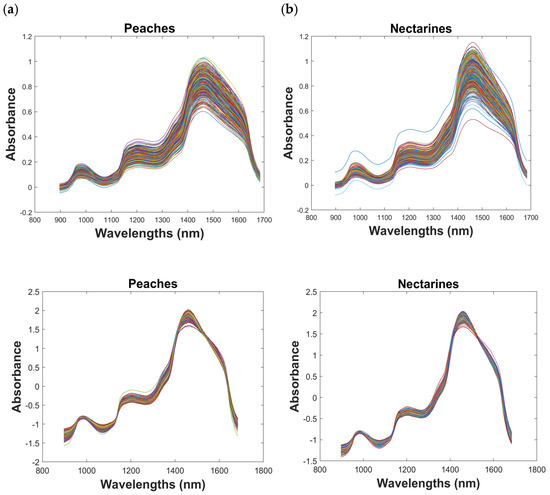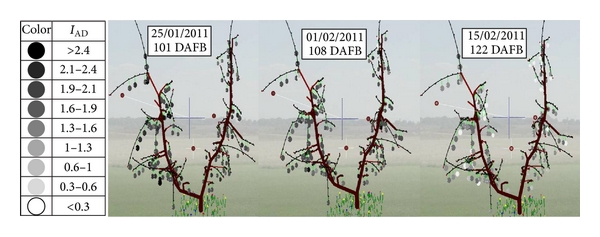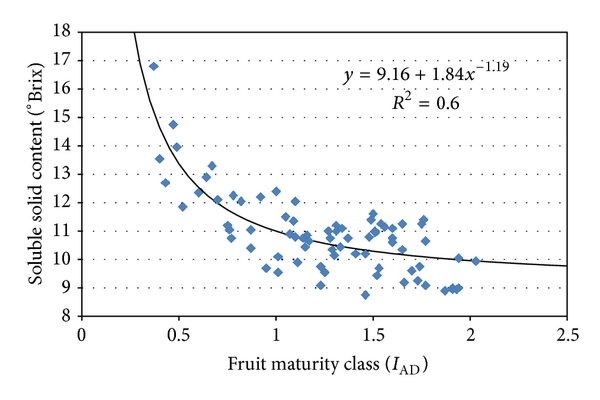October 21, 2020 at 9:14 pm | Updated October 21, 2020 at 9:14 pm | 7 min read
Quality parameters are useful in various stages of a supply chain and are used for different purposes. In peaches and nectarines, the quality parameters have been used to estimate maturity, select fruits for processing, and monitor quality. Near Infra-red (NIR) spectroscopy can be used for the non-destructive, rapid, and cost-effective chemical analysis of the internal attributes. The application of this technology for these fruits has just begun, so we provide a brief overview below.
Peaches and Nectarines are Different Fruits
Though the two fruits, peaches and nectarines, are similar in appearance and taste, they are actually very closely related variants. There is also a difference in their nutritional value.
The peach is native to china and its botanical name is Prunus persica, while the nectarine’s botanical name is Prunus persica var. Nucipersica. The nectarine has been described as the fuzz-less variety of peaches, and some seeds of nectarine can produce peach trees, so grafting is the safest way of propagating nectarines.
Subscribe to the Felix instruments Weekly article series.
By submitting this form, you are consenting to receive marketing emails from: . You can revoke your consent to receive emails at any time by using the SafeUnsubscribe® link, found at the bottom of every email. Emails are serviced by Constant Contact
Peach and nectarine are climacteric and, given their other similarities, scientists, as well as economists, link them together. The methods of fruit measurements and timing of analysis are also similar, which is another reason why they are often combined.
Older Methods of Quality Parameters’ Estimation
The traditional quality parameters are changes in the color of skin and flesh and firmness of the fruits. However, both are subjective and require personnel with skill and experience. Soluble solids content (SSC) and concentration of acids estimated in the laboratory are more reliable measures of maturity.
- Firmness is not useful as an indicator for maturity by itself, as there can be differences within a variety due to fruit size, climate, and agricultural practices. Moreover, the penetrometer, which uses a plunger of about 8 mm, involves destructive piercing of fruits.
- Soluble solids content (SSC) can be measured by portable Refractometers, which require the destruction of ten fruits to produce a representative juice sample. Also, the large number of varieties of peaches and their differences in sweetness can make SSC challenging to use as a maturity indicator.
- Acid content has to be estimated, as a favorable sugar/acid ratio is desired to maintain flavor in peaches and nectarines sold as fresh fruits. Therefore, finding the titrable acid content is essential during retailing. Traditionally, the colored indicator or pH meter methods were used. Both these methods require a simple laboratory and involve destructive sampling of juice from ten fruits. Moreover, the colored indicator analysis is cumbersome and requires titration with sodium hydroxide and the indicator phenolphthalein. Sodium hydroxide is corrosive to the skin in undiluted form and the indicator is explosive; both chemicals pose health and safety risks.

Figure 1. “Near-infrared (NIR) absorbance spectra without any preprocessing (first line) and with the standard normal variate (SNV) procedure (second line), for (a) peaches and (b) nectarines,” Baltazar, et al. 2019. (Image credits: https://doi.org/10.3390/agronomy10020152)
Using NIR Spectroscopy
Near-Infrared (NIR) is the part of the light spectrum that lies beyond the red color. NIR reacts with the bonds that hold the atoms in a compound. The absorbance, reflectance, and transmission of light by the compounds will vary based on the bonds and their position. This spectroscopy is used to determine the identity of chemicals and estimate the quantities in which they are present so compounds definiting quality can be measured; see Figure 1.
Near Infra-red (NIR) spectroscopy can be used for peaches and nectarines to estimate BRIX, titrable acids, firmness, color, and Index of Absorbance Difference.
Research around the world in the past five years has shown that NIR can accurately predict SSC, titrable acid content, and firmness in peaches and nectarines. Dry matter, however, has a predictive value that is not reliable. Instead, the Index of Absorbance Difference (IAD) can determine ripeness.
The Index of Absorbance Difference is a new maturity indicator recommended by many studies and has been tested for peaches and nectarines. Before ripening, the skin of fruits is green due to chlorophyll-a content. When fruits ripen, the color of their fruit skin changes from green to yellow, red, or orange. The index measures the de-greening. The value of the index decreases as the fruit ripens, as shown in Figure 2.

Figure 2: “Image of the fruit ripening distribution at 101, 108, and 122 days after full bloom DAFB. The white circles, as well as the circles colored with the lighter shade of grey, represent fruits at their physiological maturity stage (PM). The higher the value and the more unripe the fruit, the darker the shade of grey. Black circles represent the most unripe fruits,” Bonara et al 2013. (image credits: https://www.hindawi.com/journals/ija/2013/242461/)
IAD, can be detected in the field by NIR tools. Moreover, IAD at harvest was confirmed as a reliable indicator of post-harvest fruit shelf-life in both peaches and nectarines by an Italian doctoral work submitted to the Università di Bologna.
Critical Points of NIR Use
There are many different stages of fruit production, where quality parameter estimation by NIR can be used for peaches and nectarines.
To fix harvest time
NIR can be used to determine maturity to set harvest time by evaluation of IAD, and firmness.
- Index of Absorbance Difference: When the peaches and nectarines start to ripen, the green turns to a yellow background with red accompanied by a change in firmness. However, fruits with the same background color can have different firmness depending on their position in the canopy. So, the index IAD is considered a better indicator of harvest readiness by examining fruits on the trees. As peaches mature, their index will drop from 2.0 to 0.1. (See Figure 2).
- Firmness: Though a traditional parameter, it is still used to judge maturity and to choose fruits that will retain excellent quality at the end of transport.
Fruit selection for processing
Post-harvest NIR spectroscopy can be used to estimate BRIX to measure SSC for the selection of fruits for various fruit processing, such as the production of juice, jams, and other products. SSC values can vary in different parts of a single fruit, so two readings per peach/nectarine should be taken on the opposite sides of fruit on the equatorial plane.
Quality control during storage
NIR tools can be useful to detect the development of ripeness and flavor during storage using BRIX, titrable acid, and firmness.
Just as old apples lose their firmness and become mealy, peaches become wooly when they are old. It can also be a result of improper storage conditions when they are stored in cold storage at 0–3 °C for an extended period of time. As a result, the juice content in fruits is less, and fruits taste gummier.
Earlier wooliness in peaches was detected by penetrometer; however, NIR, which measures firmness accurately in peaches and nectarines, can also be used to identify possible wooliness in fruits stored for a month and more. “Wooly” fruits are not fit for consumption like fresh fruits, but some could be processed, so they can be sorted for various uses.
Retailing
SSC, titratable acids, and IAD index, which are based on internal characteristics of fruits, are better predictors of consumer satisfaction than external factors like color. The SSC to acid ratio increases as the fruit matures, while the IAD index decreases; see Figure 3. IAD ≤0.6 best meets consumer satisfaction for fresh fruits. A minimum soluble solid content of 11 °Brix is the optimum SSC.

Figure 3: As the IAD index decreases, the SSC in fruits increases as fruits mature. (Image credits: https://www.hindawi.com/journals/ija/2013/242461/)
Quality Meters
The F-750 Produce Quality Meter, manufactured by Felix Applied Food Science Instruments, is an example of a NIR spectrometer that can be used for peaches and nectarines for measuring SSC, titrable acids, and internal and external color. F-750 gives individual readings within a few seconds and is small enough so people can use it with one hand. Though it is meant as a general tool, it has an easy model building software to customize it for peaches and nectarines.
Best Growing Practices for Peaches and Nectarines
Farmers can use well-established agronomic practices to get good quality peaches and nectarines, which can benefit the whole supply chain. The process starts from the beginning when the trees are young. Two of the most important ones that influence fruit quality at harvest are described below.
- Tree architecture: The position of the fruit in the tree canopy is critical for excellent quality in peaches, especially color development, as the fruits require light. Pruning and maintaining an open canopy allows light to reach the lower branches. An open center is the ideal training system for the fruits and can be achieved by V or Y shaped architecture of trees. When fruits get uniform light, the crop will have better quality attributes; otherwise, fruits in a shaded canopy will have lower quality.
- Thinning: The shoot length, distribution, and the number of fruits on each shoot will also influence fruit size. To achieve an optimal density of fruits, thinning is necessary for every part of the tree. A balanced fruit number in an open, trained tree produces larger fruits. Moreover, thinning shortens the time to maturity. When fruits are unthinned, they need longer to achieve a lower IAD.
Advantages of NIR Tools
Many NIR tools, such as the F-750, are small and portable, so farmers, suppliers, fruit processors, and retailers can use them on the field, warehouses, factories, or shops, respectively. People can take as many readings as needed by NIR tools, as the method is non-destructive and gives results in real time for quick decision making. Since they can be used multiple times and on numerous fruits in a short time, the instruments bring the cost of quality analysis down and make it affordable for all people.
—
Vijayalaxmi Kinhal
Science Writer, CID Bio-Science
Ph.D. Ecology and Environmental Science, B.Sc Agriculture
Feature image courtesy of Marco Verch
Sources
Baltazar, P., Correa, E. C., & Diezma, B. (2020). Instrumental Procedures for the Evaluation of Juiciness in Peach and Nectarine Cultivars for Fresh Consumption. Agronomy, 10(2), 152. DOI: 10.3390/agronomy10020152
Bonora, E., Stefanelli, D., & Costa, G. (2013). Nectarine Fruit Ripening and Quality Assessed Using the Index of Absorbance Difference (IAD). International Journal of Agronomy, 2013, 1–9. DOI: 10.1155/2013/242461
Bonora, E. (2013). Modeling systems and vis/NIR device to improve peach and nectarine pre and post-harvest fruit maturity management. Ph.D. thesis submitted to the Università di Bologna. Retrieved from https://core.ac.uk/download/pdf/11014223.pdf
Costa, G., Noferini, M., Fiori, G., Miserocchi, O., & Bregoli, A.M. (2002). NIRs evaluation of peach and nectarine fruit quality in pre-and post-harvest conditions. Acta Hortic. 592, 593-599. DOI: 10.17660/ActaHortic.2002.592.81
Gasic, K., Reighard, G.L., Windham, J., & Ognjanov, M. (2015). Relaltionship between fruit maturity at harvest and fruit quality in peach. Acta Hortic. 1084, 643-648. DOI: 10.17660/ActaHortic.2015.1084.86
Golding, J.B., Satyan, S., Liebenberg, C., Walsh, K., & McGlasson, W.B. (2006). Application of portable NIR for measuring soluble solids concentrations in peaches. Acta Hortic. 713, 461-464. DOI: 10.17660/ActaHortic.2006.713.69
Organisation for Economic Co-operation and Development. (2005). Guidance on Objective Tests to Determine Quality of Fruits and Vegetables and Dry and Dried Produce. Retrieved from https://www.ble.de/SharedDocs/Downloads/EN/Nutrition-Food/Quality-Control/BestimmungFruechteEN.pdf?__blob=publicationFile&v=1
Ortiz, C., Barrieiro, P., Correa, E., & Ruiz-Altisent, M. (2001). PH—Postharvest technology: Non-destructive Identification of Woolly Peaches using Impact Response and Near-Infrared Spectroscopy. Journal of Agricultural Engineering Research, 78, 281-289. DOI:10.1006/jaer.2000.0570
Uwadaira, Y., Sekiyama, Y., & Ikehata, A. (2018). An examination of the principle of non-destructive flesh firmness measurement of peach fruit by using VIS-NIR spectroscopy. Heliyon, 4(2). DOI: 10.1016/j.heliyon.2018.e00531
Related Products
- F-751 Grape Quality Meter
- Custom Model Building
- F-901 AccuRipe & AccuStore
- F-751 Melon Quality Meter
- F-751 Kiwifruit Quality Meter
- F-750 Produce Quality Meter
- F-751 Avocado Quality Meter
- F-751 Mango Quality Meter
- F-900 Portable Ethylene Analyzer
- F-950 Three Gas Analyzer
- F-920 Check It! Gas Analyzer
- F-960 Ripen It! Gas Analyzer
- F-940 Store It! Gas Analyzer
Most Popular Articles
- Spectrophotometry in 2023
- The Importance of Food Quality Testing
- NIR Applications in Agriculture – Everything…
- The 5 Most Important Parameters in Produce Quality Control
- Melon Fruit: Quality, Production & Physiology
- Guide to Fresh Fruit Quality Control
- Liquid Spectrophotometry & Food Industry Applications
- Ethylene (C2H4) – Ripening, Crops & Agriculture
- Fruit Respiration Impact on Fruit Quality
- Active Packaging: What it is and why it’s important






